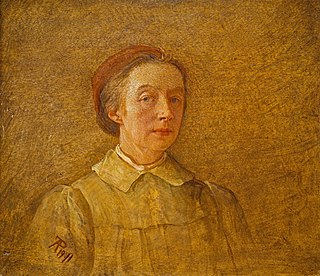
Sir Henry Raeburn was a Scottish portrait painter. He served as Portrait Painter to King George IV in Scotland.

Sir William Allan was a distinguished Scottish historical painter known for his scenes of Russian life. He became president of the Royal Scottish Academy and was made a Royal Academician.

Thomas Faed RSA (1826–1900) was a Scottish painter who is said to have done for Scottish art what Robert Burns did for Scottish song.

Colinton is a suburb of Edinburgh, Scotland situated 3+1⁄2 miles southwest of the city centre. Up until the late 18th century it appears on maps as Collington. It is bordered by Dreghorn to the south and Craiglockhart to the north-east. To the north-west it extends to Lanark Road and to the south-west to the City Bypass. Bonaly is a subsection of the area on its southern side.

James Eckford Lauder was a notable mid-Victorian Scottish artist, famous for both portraits and historical pictures.

Phoebe Anna Traquair was an Irish-born artist, who achieved international recognition for her role in the Arts and Crafts movement in Scotland, as an illustrator, painter and embroiderer. Her works included large-scale murals, embroidery, enamel jewellery and book illuminations. In 1920, she was elected as an honorary member of the Royal Scottish Academy.

Ramsay Heatley Traquair FRSE FRS was a Scottish naturalist and palaeontologist who became a leading expert on fossil fish.

Sir William Fettes Douglas (1822–1891) was a Scottish painter and art connoisseur, rising to be President of the Royal Scottish Academy.

Mary Margaret Cameron was a Scottish artist, renowned for her depictions of everyday Spanish life. She exhibited 54 works at the Royal Scottish Academy between 1886 and 1919.

Scottish art in the nineteenth century is the body of visual art made in Scotland, by Scots, or about Scottish subjects. This period saw the increasing professionalisation and organisation of art in Scotland. Major institutions founded in this period included the Institution for the Encouragement of the Fine Arts in Scotland, the Royal Scottish Academy of Art, the National Gallery of Scotland, the Scottish National Portrait Gallery and the Glasgow Institute. Art education in Edinburgh focused on the Trustees Drawing Academy of Edinburgh. Glasgow School of Art was founded in 1845 and Grays School of Art in Aberdeen in 1885.

Art in modern Scotland includes all aspects of the visual arts in the country since the beginning of the twentieth century. In the early twentieth century, the art scene was dominated by the work of the members of the Glasgow School known as the Four, led by Charles Rennie Mackintosh, who gained an international reputation for their combination of Celtic revival, Art and Crafts and Art Nouveau. They were followed by the Scottish Colourists and the Edinburgh School. There was a growing interest in forms of Modernism, with William Johnstone helping to develop the concept of a Scottish Renaissance. In the post-war period, major artists, including John Bellany and Alexander Moffat, pursued a strand of "Scottish realism". Moffat's influence can be seen in the work of the "new Glasgow Boys" from the late twentieth century. In the twenty-first century Scotland has continued to produce influential artists such as Douglas Gordon and Susan Philipsz.

Ramsay Traquair was a Scottish architect and academic with strong links to Canada. He is remembered more for his numerous publications than for his buildings, which are limited in number. He was a particular expert on Early Canadian and French-Canadian architecture.
Rev John Sutherland Black FRSE LLD (1846–1923) was a Scottish biblical scholar and contributor to the Encyclopædia Britannica and Dictionary of National Biography. He was a noted literary editor and amateur astronomer. In encyclopedic references, Black is usually just shown as J.S.B.
Sir James Lewis Caw LLD HRSA was a Scottish art historian, critic and gallery director. He argued for the existence of an independent and free-standing "Scottish school of painting" arising in the second half of the 19th century.
Annie Smith MacDonald (née Johnston) was an artistic bookbinder from Scotland, active in the 1890s and the early 20th century. She was known for her study of old binding techniques, determining how book bindings were created in the medieval era and duplicating the methods used.

The Mortuary Chapel of the Royal Hospital for Sick Children in Edinburgh is a late nineteenth-century chapel, designed by the Scottish architect George Washington Browne, with mural decorations by the Arts and Crafts artist Phoebe Anna Traquair. The chapel is designated as a "Category A" listed building by Historic Scotland. The murals are Phoebe Traquair's first professional commission, and the sole survivor of around 20 commissions instigated by Patrick Geddes' Edinburgh Social Union. They were described in 1887 as "the most important and memorable portion of the art of the Social Union" and in an August 1891 letter to her nephew, Traquair says "I myself believe that in some ways I shall never do better or maybe as well."
Lewis Balfour (1777–1860) was a Scottish Church of Scotland minister and grandfather to the author Robert Louis Stevenson.
Patrick William Adam RSA (1852–1929) was a Scottish artist. He was a joint founder of the artistic group the Society of Eight. He is mainly remembered for his landscapes and interiors.
Bellevue is a district of Edinburgh, the capital of Scotland. It lies to the south east of Canonmills, west of Leith Walk and south of Leith, incorporating the easternmost extent of Edinburgh's New Town UNESCO heritage site. The area was formerly open fields which became the second and penultimate location of the Royal Botanic Garden in 1763 .

William Borthwick Johnstone, was a Scottish landscape and historical painter, art collector, and gallery curator. He played an important role in the formation of the National Gallery of Scotland, and served as its first principal curator.














